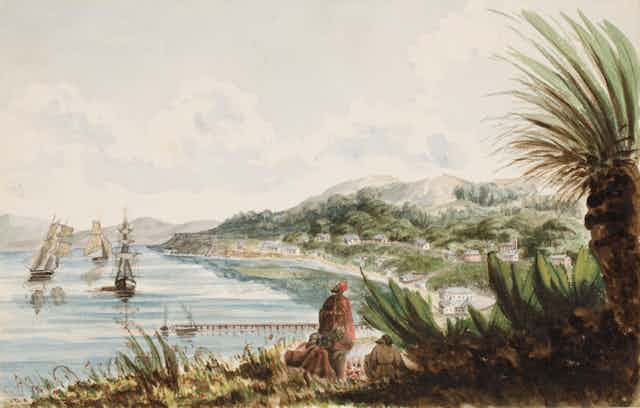Europeans have constructed a complex “sense of place” from their actual and fictive experience of the Australian landscape over the past 400 years.
The vast repository of images of the Western Australian landscape, created since the Dutch first collided with the coast in the early 1600s, documents a process of assimilation and appropriation that cultural commentator and polymath, George Seddon has described as “taking imaginative possession.”
It is a process that enables individuals to become rooted in a particular environment and to make it their own. As he explained in his book Searching for the Snowy (1994):
An environment becomes a landscape only when it is so regarded by people, and especially when they begin to shape it in accord with their taste and needs.
Unknown Land, curated by Melissa Harpley and currently on show at the Art Gallery of Western Australia is a vibrant and intriguing record of that process of establishing belongingness.

A revealing example of the difficulties of reading an unfamiliar landscape is evident in the images of Albany and the South West of Western Australia produced between 1843 and 1847 by Richard Atherton Ffarington.
When confronted by the botanical oddities of Eucalypts, Zamia palms and Xanthorrhoea, and the unfamiliar physical characteristics of the local people, he responded with interest and accuracy to record what he saw in a series of remarkable pencil drawings. This strange environment he encountered, where the leaves stayed on the trees but the bark fell off, was bewildering, intriguing and demanding of his attention.
However, Ffarington was aware that this landscape would be unintelligible to a British audience accustomed to rolling parklands, scenic vistas, and oak trees. Similarly, he was convinced that for an audience familiar with Rousseau’s notion of the noble savage – individuals unsullied by civilisation and proudly living in harmony with the natural environment – the local people in their kangaroo skin garments would seem alien and threatening.

So, when he took out his watercolours to create images to send home, he made modifications to his drawings. He opened up the scrubby undergrowth, identified pathways, replaced the scant eucalypt foliage with a dense canopy of leaves and ennobled the Aboriginal occupants of the land with red capes, elegant headdresses, and regal postures.
Whose place is this? In his pencil drawings Ffarington describes an “Aboriginal lifestyle,” a place inhabited and husbanded for thousands of years, but in his watercolours, he fabricated a form of European Arcadia.
Nevertheless, in both versions he constructed an alternative thesis to the more popular notion of Terra Nullius. These proud figures obviously own the land; it is not available for vacant possession by new arrivals, this is Aboriginal country.
Other artists had other ideas. For instance Robert Dale’s A Descriptive Account of the Panoramic View, &c. of King George’s Sound, and the Adjacent Country (1834), was designed to attract potential investors to the riches and opportunities provided by the new settlement of Albany, which
possesses every capability of forming a valuable addition to the colonies of Great Britain.

Engraved by Robert Havell and published back in England, his image of this new land shows a fertile landscape inhabited by friendly natives living in harmony with the newly arrived soldiers and settlers.
Clearly, a deal has been done, sealed with a handshake, so this land was available, and other immigrants were welcome to share the spoils.
Dale’s memorable image establishes a persistent narrative of Western Australia as a seamless and harmonious milieu, which as Janda Gooding, a former curator at the Art Gallery of Western Australia, notes:
mediated activities, absorbing and repelling ideas and attitudes to produce an overlay of harmony, continuity, and consensus.
Unknown Land documents this pervasive narrative through the proliferating images of a largely unpopulated landscape that characterise the art produced by non-Indigenous Australian artists throughout the nineteenth and twentieth centuries.
First shown together during the State’s Sesquicentenary celebrations (150 years of European occupancy) in the exhibition Colonial Eye, curated by Barbara Chapman, the works in this current exhibition are an important document of the achievements and failures of our past.

More importantly, they must be reinterpreted as a roadmap for the future. The voices of key artists and central figures in the European history of the colony — such as Lieutenant Robert Dale, Captain Phillip King, Governor George Grey, Louisa King, Richard Morrell, Captain James Stirling and others, as recorded in their diaries and letters — provide additional impetus to undertake this mission.
Unknown Land is presented in tandem with two other exhibitions drawn from the Gallery’s collection, Dissenting Voices, curated by Jenepher Duncan and Gifts to the Fallen, curated by Carly Lane, which are designed to act as a counterpoint to this narrative of consensus.
Although curated independently, the resonances are there as you move through the three gallery spaces. The central themes common to all three exhibitions reinforce the sense in which this notion of Western Australia as “unknown” was concurrently accurate and grossly misleading.
Unknown Land is an important exhibition that all Western Australians should view, should assimilate into their memory bank and then use as a reference point for future discussions about what “sense of this place” we wish to embrace.
It is a shame it has a $12.00 entry price – not that it isn’t worth such a modest investment – but this is our heritage. It is the State Art Collection, held in trust for the citizens of Western Australia. The history it presents is an important reminder of who we are, where we are, and in the decade before the bi-centenary of European occupation on the western edge of this continent, of how we intend to accommodate that past within a vision of shared belonging.
For that reason alone it should be freely available to the widest audience possible.
Unknown Land is at the Art Gallery of Western Australia from 17 September 2016 – 30 January 2017

